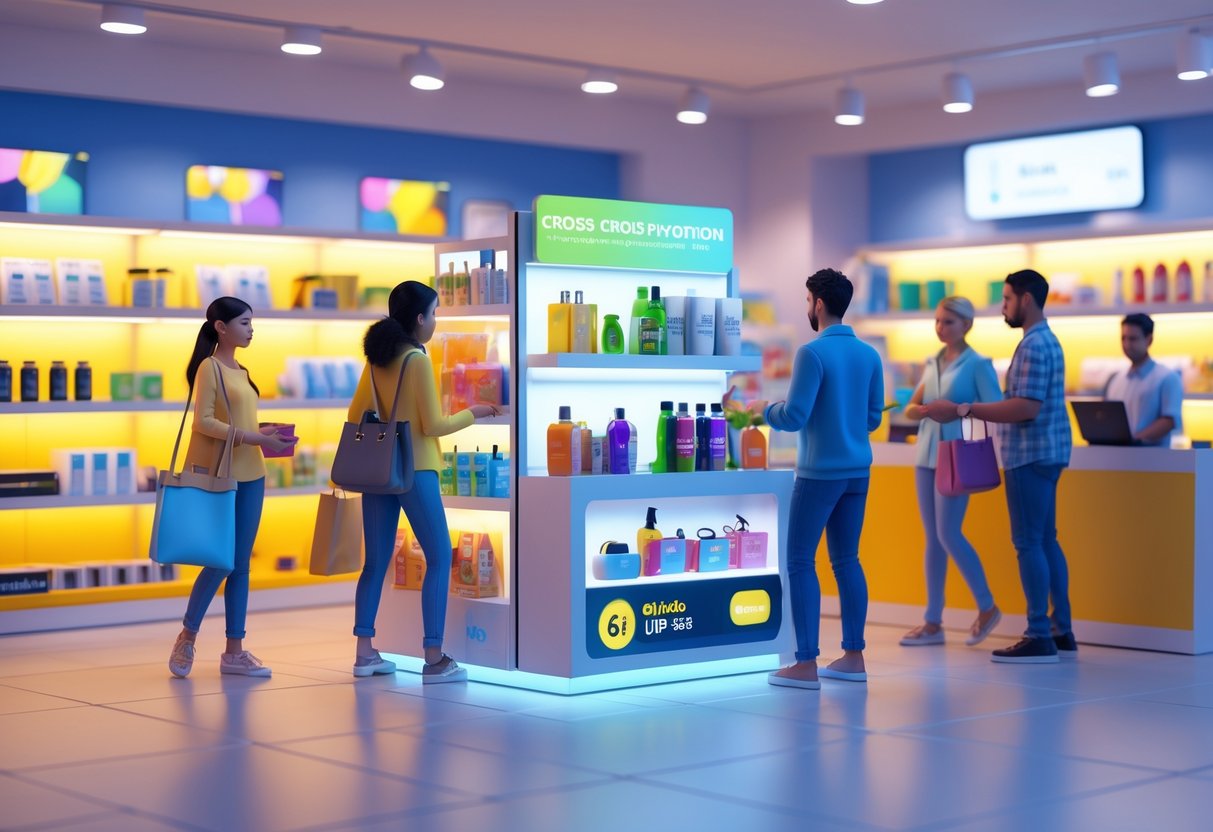Cross-Promotion: Proven Strategies for Expanding Your Brand Reach
Updated On: October 26, 2025 by Aaron Connolly
What Is Cross-Promotion?
Cross-promotion happens when two or more brands team up to promote each other’s products or services. They tap into each other’s audiences, aiming to expand their customer base and cut marketing costs by sharing resources and boosting each other’s visibility.
Key Elements of Cross-Promotion
Everything starts with finding the right partner. We need to look for brands that reach similar people but don’t actually compete with what we offer.
The whole point is mutual benefit. Both sides should walk away with something valuable—maybe new customers, lower marketing expenses, or even a credibility boost just by being seen together.
Audience alignment matters a lot. If a fitness app and a healthy meal delivery service join forces, it just makes sense because they both cater to folks who care about health.
We set clear campaign goals from the start. Maybe we want more email subscribers, a sales bump, or just to get our name in front of a certain crowd.
By sharing resources, we get more reach without doubling our spend. Pooling social media, email lists, and budgets lets us make a bigger splash than we could alone.
Differences Between Cross-Promotion and Cross-Posting
People mix up cross-promotion and cross-posting all the time, but they’re actually pretty different.
Cross-posting is just copying the same content onto different platforms. You might post the same image or message on Facebook, Twitter, and Instagram at once.
Cross-promotion is about working with another brand. Each partner creates content that highlights the other brand’s stuff, and they share it with their own audience.
Here’s a quick breakdown:
| Feature | Cross-Promotion | Cross-Posting |
|---|---|---|
| Partners | Multiple brands | Single brand |
| Content | Unique promotional material | Identical content |
| Audience | Shared between brands | Same brand’s followers |
| Cost | Shared marketing expenses | Individual posting costs |
With cross-promotion, you need to coordinate and plan with your partner. Cross-posting, though, is just something we do on our own.
Benefits for Brands
Expanded reach is the big win here. We get to show up in front of our partner’s customers without the usual cost of finding a new audience.
Cost reduction is another plus. Sharing ad spend, content creation, and promo efforts means we each put in less but get more out of it.
Enhanced credibility comes from teaming up with brands people already trust. If a respected brand promotes us, their audience is way more likely to give us a shot.
Faster growth happens because we’re not starting from zero. We piggyback on communities that already trust our partners.
We sometimes turn competitors into collaborators. Instead of fighting for the same customers, we can actually help each other grow the whole market.
Improved customer value pops up when we combine our products or services. Customers get a better, more complete solution from our partnership than they’d get from us solo.
How Cross-Promotion Works
Cross-promotion works by forming partnerships where brands share audiences and resources to hit their marketing targets. We start by choosing the right partner, then plan the campaign together, and finally, roll it out across different channels.
The Cross-Promotion Process
We kick things off by figuring out which brands have similar audiences but don’t compete with us. Usually, we reach out through professional contacts or just send a straightforward message to the marketing team.
First conversations focus on whether our values and target audiences line up and if our products or services work well together. For instance, a fitness app might connect with a nutrition brand because their users overlap.
Once we agree to work together, we set clear goals. Maybe one of us wants to build an email list, while the other cares more about social followers. These goals shape how we plan everything.
Next up: dividing the work. We decide who handles content, design, promotion, and how we’ll split the budget and set deadlines.
We need to communicate well. Regular check-ins help us stay on track and keep everyone happy with the quality and timing.
Typical Collaboration Models
Co-branded campaigns are everywhere. We might make an ebook, run a webinar, or post on social media together, showing off both our logos and messages.
With email cross-promotion, we tell our subscribers about our partner’s product, and they do the same for us. Think of a software company recommending a handy tool to their users.
Product bundling is also popular. For example, a gaming headset brand teams up with a streaming software company to offer a full package.
Social media campaigns might include swapping accounts for a day, running a joint contest, or making content together. We get to reach each other’s followers this way.
Event partnerships can be as simple as co-hosting a webinar or splitting the cost of sponsoring a conference. We both get in front of more people, and it’s cheaper.
Content swapping lets us guest post on each other’s blogs or appear on podcasts. This works especially well for B2B brands who want to reach similar professionals.
Examples of Successful Campaigns
Red Bull and GoPro nailed cross-promotion. Both target thrill-seekers, so their partnership felt natural and real.
DoorDash and Starbucks teamed up for Mother’s Day, combining delivery with coffee rewards. Their campaign hit both companies’ customers at once.
In esports, gaming gear brands like SteelSeries often join forces with streaming software companies. They offer bundles that streamers love.
Fitness apps and nutrition brands work together a lot. MyFitnessPal, for example, partners with meal delivery services to give users a full health package.
Local businesses do this too. Coffee shops and bakeries might create a morning combo deal, splitting the marketing and sharing customers.
Contests are great for engagement. Beauty brands often pair up with fashion retailers for giveaways, mixing makeup and clothes to attract people who love both.
Setting Goals and Identifying the Target Audience

We always start cross-promotion by getting clear on our goals and figuring out exactly who we want to reach. The best partnerships happen when both sides know what they want and where their audiences overlap.
Aligning Objectives
Before reaching out to anyone, we need to decide what success looks like. Setting real goals keeps us focused and makes it easier to see if things are working.
Some typical cross-promotion goals:
- Reaching new audience segments
- Boosting brand awareness in certain groups
- Driving sales with joint promos
- Cutting individual marketing costs by sharing resources
- Building credibility by being seen with a great partner
We should write down goals that are specific and measurable. Instead of “get more followers,” we might say, “add 500 new followers aged 18-25 in three months.”
Both partners need to benefit. If one side gets way more out of it, the partnership probably won’t last.
A few things to ask potential partners:
- What do we each really want from this?
- How will we know if it worked?
- When do we want to hit our goals?
- What can each of us bring to the table?
Audience Overlap Analysis
Knowing where our audiences cross over helps us pick the right partners and make content that clicks with both groups. We’re after brands whose customers would actually want what we offer.
We start by mapping out our own audience demographics: age, interests, spending habits, and where they hang out online. Then we look for brands serving similar people (but not direct competitors).
| Audience Factor | Our Business | Potential Partner | Overlap Opportunity |
|---|---|---|---|
| Age range | 18-35 | 25-40 | 25-35 age group |
| Interests | Gaming, technology | Streaming, entertainment | Tech-savvy content consumers |
| Platform usage | Twitch, YouTube | YouTube, TikTok | YouTube audience |
The sweet spot? Finding brands with similar values and interests, but who reach people at different points. Like an esports team and a gaming gear company—both serve gamers, but in different ways.
Handy tools for audience analysis:
- Social media insights
- Google Analytics
- Customer surveys
- Research on competitor audiences
We also look at how our audiences behave. Do they love video or prefer reading guides? Are they more active at certain times? This stuff shapes our cross-promotion plans.
Selecting the Right Partners
Picking the right partner can make or break a cross-promotion campaign. You want brands that fit your values and bring a fresh audience to the mix.
Evaluating Brand Fit
Brand alignment is the bedrock of a good partnership. We look past surface similarities and ask whether our values, messaging, and customer approach work well together.
We always check out a potential partner’s brand reputation. That means looking at their social media, reviews, and recent campaigns. If they’re known for bad service or controversy, teaming up could hurt our own credibility.
Brand personality matters too. If a luxury gaming brand partners with a bargain streaming service, audiences might just get confused. But a gaming chair company working with an esports event organizer? That feels like a natural fit.
Quality has to match. If we pride ourselves on premium products, teaming up with a brand that cuts corners will drag us down. Our customers will notice.
Look for brands that share our values but fill a different need in the same world. Like a headset brand and a keyboard maker—both want to reach serious gamers, but they don’t compete.
Assessing Audience Alignment
Audience overlap is key for getting the most out of cross-promotion. We want partners whose followers are similar to ours, but not exactly the same.
We start by comparing demographics: age, income, location. If they’re a perfect match, we might not reach many new people, so some difference is good.
Engagement beats numbers. A partner with 50,000 loyal fans is better than one with 200,000 who don’t care. We check their engagement rates, email opens, and website quality.
Psychographics matter too. Do both audiences share interests, values, and buying habits? A retro gaming crowd might love a craft beer brand because both value nostalgia and quality.
We like to test things out before going big. A small shoutout or newsletter feature helps us see if our audiences actually respond before we invest more.
Developing a Cross-Promotion Strategy
A smart cross-promotion strategy gives esports organizations a way to grow their reach without blowing their budget. We set clear goals, plan resources, and think through possible risks before diving into any collaboration.
Goal Setting and KPIs
Before kicking off any cross-promotion campaign, we need goals that both partners can actually measure. If we just say “increase brand awareness,” how do we know if we succeeded? We can’t.
Primary goal examples include:
- Grow email subscribers by 15% within three months
- Increase tournament viewership by 20% for the next event
- Boost merchandise sales by £5,000 during the campaign period
- Gain 2,000 new social media followers across platforms
Each goal should have KPIs we can track without hassle. For subscriber growth, let’s keep an eye on sign-up rates from partner referrals. For viewership, we’ll look at unique viewers coming from cross-promotional content.
We also need engagement metrics like click-through rates on partner content and conversion rates from collaborative posts. These numbers show whether the partnership actually drives action, not just empty views.
Quick win: Always use UTM codes on shared links so we know exactly which partner activities bring in the most traffic.
Budget and Resource Planning
Cross-promotion is usually cost-effective, but it still eats up time, content creation energy, and sometimes shared expenses. A lot of esports teams underestimate how much work a good partnership takes.
Key budget considerations:
- Staff time: Making co-branded content, coordinating campaigns, handling communications
- Production costs: Graphics, videos, or promo materials with both brands
- Shared expenses: Prize pools for joint giveaways, or costs for co-hosted events
- Platform fees: Boosted posts or ads if we’re promoting collaborative content
We should set aside about 20-30% of our regular marketing budget for cross-promotional activities. That covers both direct costs and the time our team puts into partnership management.
The best esports cross-promotions work because both partners spend less individually but reach more people. For example, a tournament organiser and a gaming peripheral brand might split ad costs and both benefit from bigger audiences.
Warning: If a partnership needs more than 40% of our marketing resources, we should only go for it if the audience reach is truly worth it.
Risk Assessment in Partnerships
Not every partnership will help our brand. We need to look at potential risks before jumping into cross-promotional campaigns—especially since esports moves fast.
Brand alignment risks worry us the most. If we team up with organisations that don’t share our values, we might hurt our reputation with fans. If we focus on family-friendly content, working with brands known for edgy marketing could push away our core audience.
Audience overlap is another issue. If we already share 70% of the same followers with a partner, there’s not much new exposure to gain. We should check our audiences before saying yes to a collaboration.
Performance imbalances can cause tension. If one partner keeps bringing in more engagement or a bigger crowd, things might get awkward. We need clear agreements about what we expect and what happens if results are lopsided.
Legal considerations matter too. We have to decide who owns co-created content, handle exclusivity clauses, and agree on what happens if the partnership ends on a sour note.
Quick tip: Try smaller, time-limited partnerships first before diving into long-term deals with new partners.
Popular Cross-Promotion Tactics

Cross-promotion tactics range from simple social media collaborations to complex product bundles and joint events. These approaches help esports organisations, gaming brands, and content creators share audiences while splitting marketing costs.
Social Media Collaboration
Social media collaboration sits at the heart of most esports cross-promotion efforts. Gaming brands often team up with streamers, tournament organisers, and other companies to create content that hits multiple audiences at once.
Common social media tactics include:
- Coordinated posts on both partners’ accounts
- Joint livestreams on Twitch or YouTube
- Account takeovers during big events
- Shared hashtag campaigns
Esports teams love using cross-promotion on social media to boost tournament announcements. For example, when Team Liquid partners with a peripheral brand, both accounts post content with the team using the sponsor’s gear.
Social media collabs work best when partners have overlapping, but not identical, audiences. A mouse maker might partner with a keyboard brand to cross-promote to the same gaming crowd.
Success metrics usually include follower growth, engagement rates, and click-throughs to partner sites or stores.
Product Bundling
Product bundling lets gaming companies give customers extra value while introducing them to complementary brands. This works especially well in esports, since players need a bunch of gear.
Popular bundles mix gaming peripherals like mice, keyboards, and headsets from different companies. Streaming software brands sometimes bundle with hardware makers to offer full setup packages.
Effective product bundling strategies:
- Starter bundles for new gamers
- Pro-level combos endorsed by esports athletes
- Tournament packages tied to big events
- Platform-specific bundles (PC vs console setups)
Gaming brands often launch limited-time bundles during major tournaments. For example, during Worlds 2024, several peripheral companies bundled their products with exclusive in-game skins or digital swag.
The trick is making sure the products actually go well together. Customers should feel like they’re getting a deal—not just buying random stuff in a box.
Joint Events
Joint events are one of the flashiest ways to cross-promote in esports. Tournament organisers regularly join forces with several sponsors to create experiences that benefit everyone involved.
Common joint event formats include:
- Multi-brand tournament sponsorships
- Product launches at gaming conventions
- Collaborative streaming marathons
- Cross-brand community competitions
Co-hosted events help brands share both costs and audiences. For example, when Red Bull partners with Riot Games for League of Legends events, both get more visibility and split production expenses.
Planning is everything here. Partners need to agree on messaging, visuals, and audience targeting so things don’t get confusing.
Event collaboration works best when brands target the same demographic but sell different things. Energy drink makers often partner with gaming hardware brands at esports events.
Referral and Loyalty Programmes
Referral and loyalty programmes open up ongoing cross-promotion chances that go beyond one-off campaigns. These systems get customers to interact with partner brands through rewards.
Many gaming platforms now run referral programs that reward users for bringing friends to partner services. For example, Discord Nitro subscribers might get bonuses for referring friends to gaming subscriptions.
Loyalty programmes often include cross-brand perks. Gamers might earn points with one service and redeem them with a partner. Twitch Prime members regularly score in-game content for multiple games through these partnerships.
Cross-brand loyalty schemes work because they keep people coming back, not just for a single promo. Members stay engaged with several brands in the network.
Programme structures usually feature tiered rewards, exclusive partner offers, and bonus points for interacting with multiple brands.
Cross-Promotion on Social Media Platforms

Social media cross-promotion lets esports brands reach new audiences through takeovers, story partnerships, and influencer collaborations. These strategies work especially well in gaming, where fans follow lots of platforms and creators.
Social Media Takeovers
Social media takeovers let guest creators or players run your account for a while. This works great in esports because fans crave behind-the-scenes content from their favourite players.
Popular takeover formats include:
- Tournament day Instagram Stories from pro players
- Twitter takeovers during big events like Worlds or The International
- TikTok takeovers sharing training routines or team house life
Set some ground rules before you start. Outline how often to post, what kind of content is okay, and any topics to avoid. The best takeovers usually last 24-48 hours—any longer and people tune out.
Choosing the right person matters. Sometimes a mid-tier streamer with active fans outperforms a huge creator with a passive following. Their audience is more likely to check out your main content later.
Quick win: Start with friendly streamers who already know your brand. They’ll be more relaxed making authentic content.
Instagram Stories Partnerships
Instagram Stories partnerships mean cross-posting content between related accounts. Esports teams, event organisers, and gaming brands use this all the time.
Common partnerships include story swaps, shared highlights, and joint polls. Teams often team up with sponsors for product showcases or match predictions.
Effective partnership strategies:
| Strategy | Best For | Typical Reach Increase |
|---|---|---|
| Story swaps | Similar-sized accounts | 15-30% |
| Shared polls | Event promotion | 25-45% |
| Behind-scenes content | Team partnerships | 20-35% |
We suggest making branded story templates for partners. That way, your brand stays consistent but partners can still add their own twist.
Time these partnerships for major events. Stories hyping upcoming matches or tournaments always get more engagement than random promos.
Influencer Collaborations
Influencer collaborations in esports go way beyond just sponsored posts. The best ones bring real value to both audiences through shared content, joint streams, or collaborative videos.
Successful collaboration formats:
- Duo queue streams where influencers play together
- Tutorial exchanges where creators teach each other new games
- Tournament predictions and analysis
- Gear reviews and setup tours
Pick influencers whose audiences overlap with yours, but not too much. For example, a fighting game streamer teaming up with a MOBA creator helps both reach new gaming communities.
Warning: If a partnership feels forced or too commercial, fans will notice—and they won’t like it.
We recommend starting with smaller, engaged creators over chasing giant follower counts. A streamer with 5,000 loyal viewers often outperforms someone with 50,000 passive ones.
Aim for ongoing relationships, not just one-offs. Regular collaborations help build real connections between your communities.
Content-Based Cross-Promotion

Creating valuable content with partner brands helps you reach new audiences while sharing production costs. These collaborations shine when both sides bring something unique to the table.
Guest Blogging
Guest blogging lets you tap into another brand’s audience while giving their readers something fresh. The trick is finding partners whose readers will actually benefit from your insights.
Start by looking for blogs with similar audiences but different services. For example, a gaming peripherals brand could write for an esports training platform’s blog about gear choices.
Write content that puts the host blog’s readers first. Skip the sales pitch. Instead, share real insights that show your expertise naturally.
The host blog gets expert content without extra work. You get in front of people who already trust the host’s recommendations.
Best practices for guest blogging:
- Learn the blog’s style and audience before reaching out
- Offer fresh takes the blog hasn’t covered yet
- Give actionable tips readers can use right away
- Stick around to reply to comments
Co-Branded Content
Co-branded content combines two brands’ strengths to make something better than either could do alone. Think research reports, guides, or educational resources that help both audiences.
The content should feel natural—not forced. Two brands that fit together can create guides covering topics from different angles.
For example, a streaming software company and a microphone maker might team up for a “Complete Streaming Setup Guide.” Each brings their expertise and both reach new customers.
Successful co-branded content includes:
- Value for both audiences
- Balanced brand representation
- Professional design with both identities
- Promotion on both brands’ channels
Track downloads, shares, and leads to see how things go. The best co-branded content keeps pulling in attention long after launch.
Podcast Collaborations
Podcasts let you reach engaged audiences who trust their hosts. Cross-promotion through podcasts can look different depending on your goals.
Guest appearances let you share what you know while the host gets fresh content. Prep talking points that actually help listeners, not just pitch your brand.
Podcast swaps work well if both shows have similar-sized audiences. You appear on their show, they come on yours, and both sides get new ears.
Sponsored segments feel more genuine than normal ads because hosts usually read them themselves. Their endorsement means a lot to loyal listeners.
Podcast collaboration formats:
- Expert interviews
- Co-hosted episodes
- Sponsor shoutouts
- Cross-promotional announcements
Pick podcasts where your target audience actually hangs out. If you’re a gaming brand, stick to gaming or tech podcasts—not just any business show.
Webinars and Online Tutorials
Webinars offer interactive experiences that help build trust through live engagement. They also give brands a chance to show off their expertise side by side. Educational content marketing really shines in this format.
When experts from different but related brands team up for joint webinars, audiences get a richer experience. For example, an esports coaching platform might join forces with a gaming equipment brand to host a session on “Performance Optimisation for Competitive Gaming.”
The live format lets people ask questions and get answers right away. This immediate connection feels more genuine than pre-recorded videos, and both brands get to flex their knowledge.
After the event, send out the recorded version and any extra resources. Plenty of folks prefer to learn at their own pace after the live rush is over.
Webinar success factors:
- Pick topics that matter and offer clear value
- Promote everywhere you can—across both brands’ channels
- Make it interactive with Q&As
- Give attendees downloadable resources
Track how many people show up, how engaged they are, and what they do after the webinar. The best webinars keep bringing in leads long after the broadcast ends.
Cross-Promotion in Email Marketing

Email marketing gets a serious boost when we join forces with other brands. By partnering up, we reach new audiences and strengthen bonds with our current subscribers.
Co-Branded Email Campaigns
Co-branded emails let us collaborate with another business on shared content. Both brands show up in the same email and send it to their own lists.
The trick is finding a partner with a similar audience but no direct competition. Think: a gaming headset company teaming up with a streaming software brand.
Quick win: Try a simple product bundle promotion. Each brand can mention the other’s product and toss in a special discount code.
Both sides need to pull their weight for these campaigns to work well. We split up the design, the writing, and the promo calendar so things stay fair.
Warning: Always start small. Not every audience loves co-branded content.
Set clear expectations before you get started. Decide who does what, when the emails go out, and how you’ll measure results.
Promotional Emails and Newsletters
Our regular newsletters become cross-promotion tools when we highlight other brands or content alongside our own. This keeps things fresh for subscribers without bombarding them.
We can plug our latest blog, share social content, or tease events—all in one email. Every piece helps drive traffic to the others.
A clear hierarchy works best:
- Main promotion (about 60% of the email)
- Secondary content (30%)
- Social links or bonus items (10%)
Short and punchy beats long-winded every time. We want readers to click through, not get every detail in their inbox.
In practice: If we’re hyping a tournament, we’ll drop a quick highlight in the newsletter, link out to a full blog recap, and tack on our social hashtag for live updates.
Visuals make a big difference. Screenshots, GIFs, or a short video preview can make emails way more clickable.
Offline and In-Store Cross-Promotions

Physical stores offer some pretty unique ways to create memorable cross-promotions. Displays, events, and sponsorships put products in front of shoppers right when they’re ready to buy.
Cross-Promotional Displays
Smart product placement boosts sales when you pair up complementary items. Gaming shops often put headsets next to keyboards or stash energy drinks by the gaming chairs. These setups naturally grab shoppers’ attention.
Digital displays crank things up even more. Interactive screens can show off demos or spotlight bundle deals. Some stores even use motion sensors to trigger promo messages as people walk by.
Key display strategies:
- Keep complementary items close together
- Use clear signs to show bundle savings
- Put displays where people can’t miss them
- Add product demos if possible
Physical displays open the door for impulse buys. Someone picking up a gaming mouse might snag a mousepad too if there’s a little discount and both are right there. This simple move can bump up average transaction values by 15-20%.
Event Marketing and Sponsorship
Events bring brands together in ways that feel natural to attendees. Gaming tournaments often pull in several sponsors, giving everyone a shot at cross-promotion. You’ll see energy drink brands teaming up with hardware companies for prize packs or exclusive merch.
Local events are gold for smaller businesses. A gaming café might link up with a pizza shop for meal deals during tournaments. Both places benefit from shared customers and more foot traffic.
Effective event partnerships:
- Pick partners who share your target audience
- Offer deals exclusive to the event
- Create co-branded merch or giveaways
- Plan joint activities that get people involved
Sponsoring events lets brands connect with highly engaged crowds. When people are already hyped for the main event, they’re much more open to checking out what event partners have to offer.
Measuring the Effectiveness of Cross-Promotion

If you want to know whether your cross-promotion is actually working, you’ve got to track the right numbers. Set up tracking with UTM parameters, dig into Google Analytics, and watch social engagement to see what’s really moving the needle.
Setting UTM Parameters
UTM parameters are little codes you tack onto your links to track where clicks come from. They’re essential for figuring out which partnerships are bringing in visitors.
For each campaign, create unique UTM parameters for every partner. Use utm_source for the partner name (like “partnerbrand”), utm_medium for the channel (maybe “cross-promo”), and utm_campaign for the campaign title.
You’ll want to use all five UTM parameters:
- utm_source: The partner or platform
- utm_medium: The marketing channel (email, social, banner)
- utm_campaign: The campaign name
- utm_content: Different versions of the same ad
- utm_term: Paid search keywords (if those apply)
This setup shows you which partnerships drive the most traffic and sales. Focus on what’s working and double down there.
Using Google Analytics
Google Analytics gives you a clear look at how cross-promotion traffic acts on your site. Check the Acquisition reports for UTM-tagged campaigns and compare conversion rates between partners.
Keep an eye on key metrics:
- Session duration: How long people stick around
- Bounce rate: Who leaves after just one page
- Goal completions: Newsletter signups, purchases, whatever matters to you
- Revenue attribution: Sales from cross-promotion traffic
Set up custom segments to separate cross-promotion visitors from everyone else. This helps you see if these folks behave differently.
Make sure your conversion goals match what you want from each campaign. If it’s about awareness, track views and time on site. If you want sales, watch for purchases and revenue.
Analysing Social Metrics
Social platforms offer detailed stats on your cross-promotion posts. These numbers show how well your content lands with both your audience and your partner’s followers.
Track likes, comments, shares, and saves to measure engagement. High engagement usually means people are interested and paying attention.
Watch these social metrics:
- Reach: Unique users who saw your content
- Impressions: Total times your content showed up
- Click-through rate: Who clicked your links
- Follower growth: New followers during the campaign
Compare how your campaigns do across different platforms and partners. Sometimes Instagram wins, sometimes LinkedIn surprises you.
Use each platform’s analytics tools—Instagram Insights, Facebook Analytics, Twitter Analytics—for deeper breakdowns. Track which content types (videos, images, stories) perform best so you can plan smarter next time.
Best Practices and Tips for Success

Great cross-promotion really comes down to three things: keeping your brand identity clear, nurturing partnerships beyond just one campaign, and staying organised with good planning. These basics help esports organisations build trust and create lasting, effective partnerships.
Maintaining Brand Consistency
Brand consistency is huge when you’re sharing marketing space. Your audience has to recognise your voice and values, even when you’re next to another brand.
Lay down clear brand guidelines before you team up. Spell out your logo rules, colours, voice, and messaging style. Make sure your partner sees these early.
Build co-branded materials that let both brands shine without blending them into a mush. Maybe use complementary colours or alternate logos rather than mixing everything together.
Quick win: Show your cross-promo content to your own followers first. If they can’t spot your brand instantly, tweak the design before launch.
Keep tabs on how your brand appears everywhere—on social, in emails, at events. It should always feel like you, not a watered-down version.
Building Long-Term Relationships
One-off partnerships rarely deliver the best results. The strongest collaborations grow over time, with trust and shared audiences building up slowly.
Start small before you go big. Try a simple social swap or content exchange to test the waters and see if your audiences mix well.
Keep the lines open. Even if you’re not running a campaign, check in with partners every month. Share what you’re learning, talk about new ideas, and keep the relationship alive.
Track value beyond just the usual metrics. Word-of-mouth and reputation grow through repeated exposure, not overnight. Partners who bring in quality audiences again and again become your go-to allies.
Take notes on what works with each partner. Everyone has their own style, timing, and content preferences. Build up your playbook for smoother campaigns down the road.
Creating a Content Calendar
Cross-promotion needs more coordination than solo campaigns. A content calendar keeps things from clashing and makes sure your promos hit at the right time.
Map out both brands’ schedules before you plan anything. Product launches, tournaments, and seasonal pushes all need breathing room so you don’t overwhelm your audience.
Plan themes that work together, not against each other. If your partner’s doing educational content, maybe your piece can show practical uses.
| Planning Phase | Timeline | Key Actions |
|---|---|---|
| Initial Planning | 6-8 weeks before | Agree on themes, audience, and what success looks like |
| Content Creation | 4-5 weeks before | Make the materials, approve designs, test the message |
| Launch Prep | 1-2 weeks before | Schedule everything, set up tracking, brief the teams |
| Active Campaign | Campaign duration | Watch performance, respond to feedback, tweak as needed |
Leave some buffer time in your schedule. Cross-promos usually need more approvals and edits than single-brand stuff. Rushing just hurts quality and the relationship.
Use shared tools both teams can access. This keeps everyone on the same page and cuts down on crossed wires.
Frequently Asked Questions

Cross-promotion brings up all sorts of practical questions—about partnerships, creative ideas, and tracking results. Here are some of the questions we get most often when brands are figuring out how to collaborate.
What are some successful examples of cross-promotional campaigns?
Red Bull and GoPro pulled off one of the most famous partnerships in marketing. Both brands go after thrill-seekers and extreme sports fans. Red Bull sponsors the action; GoPro captures it all on camera.
DoorDash and Starbucks teamed up for a Mother’s Day promo. People could order their favourite coffee through DoorDash, giving both brands access to new customers—and making life easier for everyone.
Thursday Boot Company joined forces with Cobbler’s Choice shoe care. The boot company included cleaning products in purchases, while Cobbler’s Choice promoted the boots on social. Simple, but it worked.
Could you share creative ideas for executing a cross-promotional strategy?
Product bundles are a classic. Imagine a bubble bath company partnering with candle and skincare brands. The bundle turns into a full-on relaxation kit, and everyone gets exposure to new customers.
Social media takeovers are another fun one. One brand runs the other’s Instagram for a day, bringing fresh content and introducing followers to something new.
Contest giveaways get people involved fast. Coca-Cola and Domino’s once ran a joint contest for pizza and drinks. To enter, people had to follow both brands—so both companies grew their social reach in a hurry.
How do cross-promotional activities offer benefits to partnering brands?
Cost sharing makes pricey marketing campaigns doable, even for smaller brands. Partners split up advertising expenses, venue costs, and production fees. That way, each brand keeps its marketing budget in check without having to sacrifice campaign quality.
Audience expansion happens way faster than with old-school marketing. Each partner instantly taps into the other’s customer base. Why spend months building an audience from scratch when you can just swap fans?
Trust and credibility get a boost through association. When a well-known brand teams up with a newer company, it lends its reputation. Customers see the partnership as a kind of social proof, thinking, “Hey, if they trust them, maybe I should too.”
What are the components of an effective cross-promotional campaign?
Clear goal setting keeps everyone on the same page. Partners need to agree on what they want—whether that’s more sales, better brand awareness, or just fresh leads. These goals guide every step of the campaign.
Partner selection takes a bit of legwork. Look for brands that don’t compete with you but offer something that fits well alongside your product or service. Check out their reputation, their past partnerships, and what they stand for before jumping in.
Resource allocation needs some upfront planning. Decide who’s in charge of content, design, and campaign management. Set budgets, timelines, and what “good enough” looks like before you get started.
Performance tracking shows you if things are actually working. Use Google Analytics to watch website traffic and conversions. Email platforms can tell you about open rates and clicks. Social media analytics reveal engagement and reach.
In what ways can cross-promotion be effectively implemented on social media platforms?
Co-created content really shines across different platforms. Partners might team up to make infographics, videos, or carousel posts. Sharing these on both brands’ accounts boosts reach and engagement.
Livestream collaborations work especially well on Instagram and YouTube. Brands can co-host product launches, Q&As, or even educational sessions. The live format adds a sense of urgency and gets people interacting in real time.
Hashtag campaigns make tracking results a lot easier. Come up with a unique hashtag both partners use throughout the campaign. That way, you can measure reach, spot user-generated content, and build some buzz around the partnership.
How have sports brands leveraged cross-promotion to expand their reach?
Sports brands love teaming up with athletes and fitness influencers. These partnerships feel way more authentic than traditional ads.
Gap, for example, worked with pop star Troye Sivan for their fall campaign. That move drew in both fashion lovers and music fans—pretty smart, right?
Event sponsorships open up all kinds of partnership opportunities. Sports brands often sponsor tournaments and also work with equipment manufacturers.
These collaborations put both brands in front of fans who already care about the sport. It’s a win-win for everyone involved.
Fitness apps also join forces with sports clothing brands all the time. The app shows off workout gear, and the clothing brand shares fitness content.
Together, they give health-conscious folks a full lifestyle experience. It’s not just about selling clothes or workouts—it’s about building a whole vibe.

